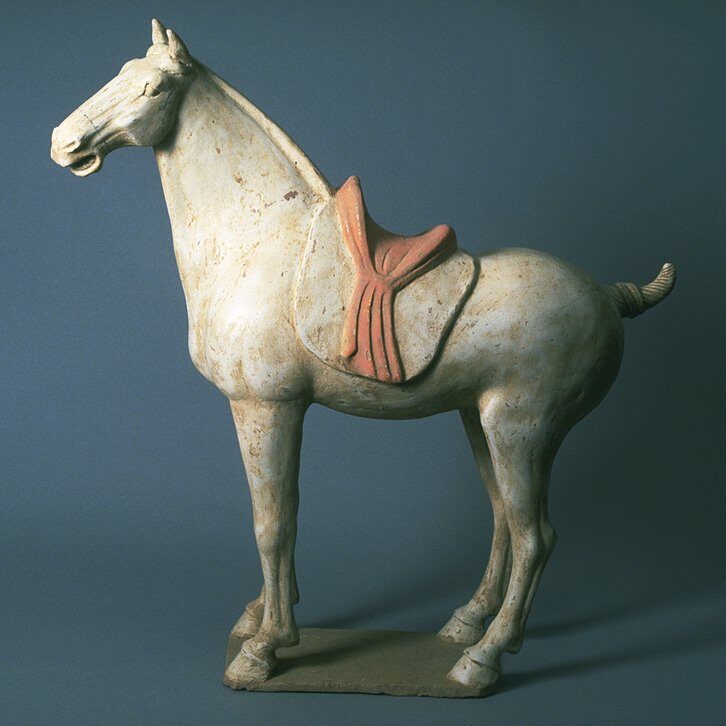Horse
Chinese

Description
March 28 2009
China’s trade with regions to its west began in earnest in the second half of the second century CE, spurred by the keen interest of the emperors of the late Han dynasty (206 BCE–220 CE) in foreign goods and cultures. During this period, Chinese controlled the international trade route, which came to be known as the Silk Road. In the Tang empire, arts and culture thrived as abundant materials and ideas poured into China through trade along this route.
One of the most vital imports into China was the fast horses of Ferghana and Sogdia (present-day Uzbekistan). Horses were crucial to the success of the Han armies over nomadic invaders from the north and it was common for Han military officials to adorn their tombs with sculpted figures of this important animal. Contemporary ideas of the afterlife required that a tomb be equipped with everything necessary to life there, and though at one time live humans and animals were buried with kings, by the Han dynasty clay models were used as substitutes and commonly buried with people of means. The practice of using mortuary pottery to fulfill the needs of the departed continued into the Tang dynasty, when this molded horse was created.
Subject Matter:
This is an earthenware polychrome mingqi (明器, literally "bright objects") horse figure of the Tang Dynasty (618-906). The presence of a horse and rider within the tomb would indicate the wealth and high status of the owner. Horses were highly prized during the Tang dynasty as they played a significant role in the Li Imperial family's rise to power; they became symbolic of power and were considered to be the embodiement of spirit of the great Tang empire.
The Chinese love affair with the horse began in the first century C.E., when Chinese troops trekked across the forbidding Taklamakan Desert in search of allies to aid in their battles against marauders from the north. On the plains of Ferghana (modern Kazakhstan) they found the best possible weapon: thousands of long-legged, swift-running wild horses. From that point onward, model horses appear in the tombs of military leaders to accompany their masters in the afterlife.
This is an especially well preserved example of a molded terracotta horse. Much of the original painting has faded or flaked off, but the orange saddle is still vivid and traces of black reins are visible on the horse’s cheek.
China’s trade with regions to its west began in earnest in the second half of the second century CE, spurred by the keen interest of the emperors of the late Han dynasty (206 BCE–220 CE) in foreign goods and cultures. During this period, Chinese controlled the international trade route, which came to be known as the Silk Road. In the Tang empire, arts and culture thrived as abundant materials and ideas poured into China through trade along this route.
One of the most vital imports into China was the fast horses of Ferghana and Sogdia (present-day Uzbekistan). Horses were crucial to the success of the Han armies over nomadic invaders from the north and it was common for Han military officials to adorn their tombs with sculpted figures of this important animal. Contemporary ideas of the afterlife required that a tomb be equipped with everything necessary to life there, and though at one time live humans and animals were buried with kings, by the Han dynasty clay models were used as substitutes and commonly buried with people of means. The practice of using mortuary pottery to fulfill the needs of the departed continued into the Tang dynasty, when this molded horse was created.
Since the Qin dynasty (221 - 206 BCE), ceramic figures have been used to replace human sacrifice in burial practices as mingqi as a way to provide for the deceased. Mingqi could include houses, towers, gates, granaries, livestock pens, chicken coops, wells, cooking stoves, storage vessels, dishes, incense burners, and lamps. Figures could include horses, dogs, anthropomorphic animals and people such as officials, guardians, servants and entertainers. By the Han dynasty, they also included representations of common people engaged in the activities that consumed their daily lives such a cooking. The tombs in southern provinces of Sichuan and Shaanxi have revealed a vast array of figures in playful and humorous poses. As grave goods, these mingqi included everything one would need to ensure a comfortable transition into the afterlife. The number of ceramic mingqi items in a tomb could reach numbers of a few to several hundred objects.
Physical Description:
This is an earthenware model of a horse dressed in a saddle blanket and saddle. It has a short, upward pointing tail and trimmed mane. The saddle is painted with reddish mineral pigment.
Usage Rights:
If you are interested in using an image for a publication, please visit https://umma.umich.edu/request-image/ for more information and to fill out the online Image Rights and Reproductions Request Form.